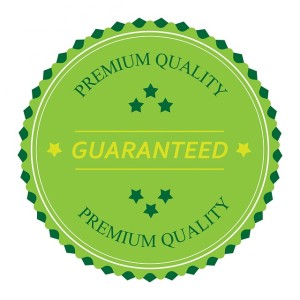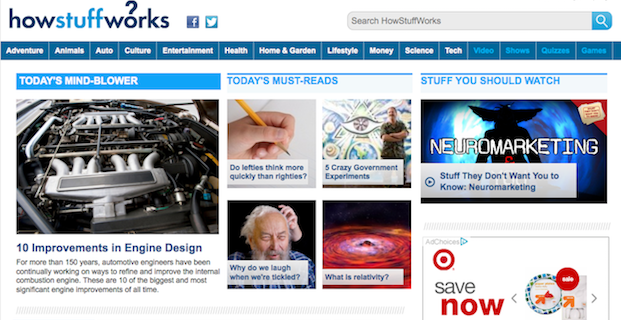by Mark Bloom | Oct 3, 2016 | Small Business Advice

The Longer You Wait, The More Difficult It’ll Be
As of 2016, nearly 3.5 billion people, about 40 percent of the world’s population, are connected to the Internet in some way. In the United States, about 87 percent of the country’s men, women and children go online. Of that 13 percent who don’t use the Internet:
- Over half (57 percent) are age 50 or older.
- About a third never earned a high school diploma.
- And almost a quarter earn less than $30K a year.
So unless your primary target market focuses on poor, uneducated retirees, your business needs to have an active (or better, interactive) online presence. Your business needs to be growing its Internet marketing activities year after year, because it’s the digital economy that’s expanding. By 2020, there may be as many as 20 billion Internet-connected devices (and only 7.5 billion people) in the world.
It Starts with a Website
Most businesses — including startups and nonprofits — now have a website. But that’s only the beginning if you want to really engage your customer base. If all your website does is list your business name, store hours, and contact information, you have a yellow pages entry, not a website. If you’ve paid someone to build your website but have never received a call or email from a potential customer who found you online, your website isn’t doing you any good.
A website is more than a 24/7 storefront in the digital economy. Your site can do so much more; all it needs is some attention. The principals at Ray Access have always maintained that “if you’re ignoring your website, your website’s ignoring you.” To tap into the digital economy of the future, you need to start now to lay the groundwork.

The Digital Economy Is Waiting for You
Not every business needs to be engaging social media. If your customers use it, then you need to engage them there, if for no other reason than to keep your company’s name in front of their eyes. (In fact, engaging social media is worthy of a whole series of future blog posts.) But every business can benefit from an active website.
To sell your products or services, your business needs a website that accomplishes a number of goals:
- Attracts potential customers — not just “eyeballs,” but the right “eyeballs”
- Answers questions about your business and your industry
- Presents your business as a leader in your field with a distinct advantage
- Establishes trust — because you do what you say you’re going to
- Helps people like you — not in the Facebook sense, but in a real-world way
- Persuades visitors to contact you
Let Ray Access Get Your Business on Track
You may think this is a tall order, but this is exactly what Ray Access provides its clients. Website content is the vehicle that helps you reach your business goals. A business blog provides your company an outlet to educate your audience and provide answers that people are searching for.
In the new digital economy, no one is going to beat a path to your door, even if you have the world’s best mousetrap. You need to engage the Internet to participate. You need an active website and a vibrant blog. You need Ray Access.
Ray Access is a content marketing firm that delivers targeted words to empower your business. Contact us about your specific project to receive a quote or discuss your needs. We write website copy, blog posts, e-newsletters and more. Everything we do is thoroughly researched, professionally edited and guaranteed original.
by Elle Ray | Apr 6, 2014 | Content Provider
Why Your Website Needs Useful Content
Everyone has been telling you that you need “quality content” on your website. They repeat it so often and with such verve that you have begun to believe it. After you realize how difficult it is to produce content that’s actually useful, you take a pause and wonder: “What’s the point of all this?” Well, you’ve come to the right place. Let us explain.
What Is “Quality Content?”

We first have to define what we mean when we refer to quality content. There may be many subjective definitions for what constitutes quality content, but here at Ray Access, we like to simplify, simplify, simplify. To us, quality content is just useful information: how-to tips, solid advice backed by facts or insightful articles that can actually help a reader reach a decision. Think of this way: Quality content is something that readers would want to share with their friends.
For example, let’s pretend there’s a company called Asheville Plasterworks. They make plaster-of-Paris masks and puppets. It’s a niche market, but they supply the local theater companies and make one-of-a-kind pieces for city parades. On their website and blog, they might feature information about the history of masks, how to incorporate puppets in a school project and what kinds of “green” materials they use to make their products. They have vision and imagine what their readers might want to read about. This quality content will attract a new audience, which is one of the things a website should do.
Why Quality Content Works
 That was one example, but there are many others. Quality content works because it attracts people and turns those visitors to your website into customers. Quality content not only differentiates your company, but it also describes the benefits of your products or services.
That was one example, but there are many others. Quality content works because it attracts people and turns those visitors to your website into customers. Quality content not only differentiates your company, but it also describes the benefits of your products or services.
When visitors arrive at your website, they’ll scan for whatever is useful or important to them. If you can supply that information, they’ll be grateful. They may become a customer. They may even share a link they think will benefit others, or they think it’s especially funny or practical. When your website reaches that level, you will know you have quality content.
The Goals of Quality Content
So what are the goals of quality content? They are:
- To get you noticed in the sea of the Internet
- To draw new people to your website
- To convert visitors into customers
- To get people talking about your company
- To establish yourself as an expert in your field
But the way to reach these goals — and this is important to learn — is to give stuff away. Not swag or prizes, but information. If you can actually help people, they’ll remember you. If you can give them something that they want or need, they’ll be more likely to recommend you. They’ll be more likely to spread the word about you as your informal ambassadors. They’ll be more likely to buy from you.
On the other hand, if you lure people to your website with the promise of help, but you don’t deliver what they’re looking for, they’ll move on. They’ll forget you. Or worse, they’ll spread the word that you’re unreliable.
So give your audience what it wants. Provide quality content. If you can’t do it on your own, quality content is what we deliver. Every time.
Ray Access is a content marketing firm that delivers targeted words to empower your business. Contact us about your specific project to receive a quote or discuss your needs. We write website copy, blog posts, e-newsletters and more. Everything we do is thoroughly researched, professionally edited and guaranteed original.
by Mark Bloom | Mar 30, 2014 | Website Content
5 Tips That Can Help Your Site Right Now
Websites matter. A good website draws people in and coverts them into customers. The question everyone asks us is: “What makes a website good?”
So let us answer this question for all of you at once so you can improve your website. We’ve written — and rewritten — many websites. You can see several examples of our work in our Portfolio. We believe that if your website isn’t making you money, then it’s costing you money. And if that’s where you are, then you have two choices:
- Invest in your website to make it the marketing engine it could be.
- Use your website just as a Yellow Pages entry, listing your company name, phone number, hours and address. One page should do it, even if you add a pretty picture.

If you decide to go with option #1 above, here are five steps to get you started:
1. Update the Design
Nothing turns visitors away faster than a design that looks straight out of the 1990s. Technology has changed; so should your website. Hire a designer who listens to what you want and can make specific and helpful recommendations. Find a programmer who can make the vision work. This is an investment in your company, the same as redecorating a storefront.
2. Brand Your Look
If necessary, update your company logo. Choose a few colors for your website. Select a couple typefaces. Use them consistently throughout your new website. These things help establish your brand.
3. Place Contact Info
This is really the number one thing we see wrong with many websites. Your contact information — email address or telephone number — should appear on every single page of your website. In the age of search engines, your visitors don’t always enter your website on the Home page. Make it easy for them to contact you. This seems like a simple thing, but you’d be surprised how many websites get it wrong.
4. Simplify Your Message
Each page of your website should focus on one thing: who you are, what you do, where you work, how you work, what sets you apart. Whatever the purpose of that page, it should be clear and easy to discern. Don’t try to be clever. Be clear and concise, and you’ll win converts.

5. Add New Content
Once you’ve accomplished the previous four steps, you’re ready to tackle this one. Adding fresh content, on your website pages and in a consistent blog, does more to get you noticed than anything else. The other steps are important so that when new potential clients arrive at your website, they aren’t immediately repulsed, but this is the step that gets them there.
This is also the very thing that Ray Access can help you with. This is what we do, and we’ve helped other businesses improve their reach and their success. We can help you, too. Contact us if you want to learn more. We’ll assess your website and provide an honest, objective appraisal.
Ray Access is a content marketing firm that delivers targeted words to empower your business. Contact us about your specific project to receive a quote or discuss your needs. We write website copy, blog posts, e-newsletters and more. Everything we do is thoroughly researched, professionally edited and guaranteed original.
by Elle Ray | Feb 13, 2014 | Website Content
How to Get a More Profitable Business Website
You can’t escape it. Sooner or later, you’ll need to provide business information — in writing — to clients, prospects, the government or the public at large. Whether you run a small business or occupy a small corner of the org chart at a multinational corporation, you need to be able to formulate a persuasive sentence.

If you’re one of the many businesspeople who lack writing skills, you should practice more. As more of your communication ends up online, more people will be influenced, either positively or negatively, by your words. Improving your writing can result in marked improvement in your business options. There’s no substitute for practice, but here are a few pointers to put you on the right track.
1. Less is more.
On a website, concision matters. Ironically, as written information becomes more important, people are less willing to read. Use words sparingly, cut out the florid prose and avoid meandering sentences. As Zorro taught his son: “Get in, make your Z and get out!”
2. Avoid jargon.
No one likes reading about “blue-sky solutioneering” and “strategical synergies” that ultimately mean nothing. If you mean “brainstorming” and “opportunities to work together,” simply say it. While jargon can be unavoidable when writing for a specific audience, use plain language whenever possible.
3. Write once, check twice.
It’s hardly fair — typos happen — but people judge you for those mistakes anyway, and harshly. To cut down on those mistakes, proofread immediately after you write and then again hours or even days later. Nothing is more embarrassing than a stupid typo in an otherwise fine document.
4. Write once, check twice.
 Yes, again. This time, re-read your work to catch errors in tone that might cause trouble. For instance, if you’re upset or angry, you may write something you don’t actually want anyone else to read. Make sure your work says what you want it to say and how you want it to say it, before letting it reach its audience.
Yes, again. This time, re-read your work to catch errors in tone that might cause trouble. For instance, if you’re upset or angry, you may write something you don’t actually want anyone else to read. Make sure your work says what you want it to say and how you want it to say it, before letting it reach its audience.
5. Pay attention to names, titles and genders.
The one thing more embarrassing than a typo is calling Mr. Smith “Ms. Smith.” If you’re not sure about the spelling of a name, job title or gender, check with someone who knows (like an assistant) or use gender-neutral language. Get the names wrong, and your readers will question everything you write.
6. Save templates.
Whenever you write a blog post or article, save it as a template for future use. You can save time and avoid common errors by using an existing document when you begin a new piece. Keep the headers, bullets, references and company information so you just have to fill in the new content.
7. Be professional, not necessarily formal.
 Business communication needn’t be formal. While formal language works for legal documents and job applications, it can obfuscate your meaning. Remember, however, that informal writing doesn’t mean being unprofessional. Keep personal comments and off-color jokes out of your business writing.
Business communication needn’t be formal. While formal language works for legal documents and job applications, it can obfuscate your meaning. Remember, however, that informal writing doesn’t mean being unprofessional. Keep personal comments and off-color jokes out of your business writing.
8. Remember the 5 W’s (and the H).
Your writing should answer all the questions your audience might ask: Who, what, when, where, why, and how. Who is your audience? What should they know? When and where will it apply? Why is it important? And how should they use it? Use the 5W+H formula to ensure your information is complete.
9. Include a call to action.
 Business websites are meant to achieve a purpose, so include a call to action on every page. A call to action directs the reader to do something. Don’t leave it to your readers to decide what to do with the information you’ve provided; most won’t bother. Tell them what to do and how to do it.
Business websites are meant to achieve a purpose, so include a call to action on every page. A call to action directs the reader to do something. Don’t leave it to your readers to decide what to do with the information you’ve provided; most won’t bother. Tell them what to do and how to do it.
10. Don’t provide too many choices.
Ideally, you shouldn’t provide any choices to your readers. Just tell them what you want them to do and why they should do it. At most, give them two options and ask them to pick one. Too many choices can lead to “analysis paralysis,” which probably isn’t the result you’re hoping for.
11. What’s in it for readers?
Effective writing describes benefits, not features. Your readers want to know how to make their lives better. For example, nobody cares that Windows 7 runs in 64-bit mode. What they care about is that 64 bits runs faster than 32 bits, and getting work done more quickly is a benefit.
12. Hire a freelancer.
If writing is not your strength, hire a professional writer. Freelancers aren’t just for marketing material; a good freelance writer can produce corporate newsletters, blog posts, wiki entries, and much, much more. Expect to pay $35 to $45 an hour for good writing. Anyone who charges less is either not very good or not very business savvy. Ray Access is proven content provider in Asheville.
Ray Access is a content marketing firm that delivers targeted words to empower your business. Contact us about your specific project to receive a quote or discuss your needs. We write website copy, blog posts, e-newsletters and more. Everything we do is thoroughly researched, professionally edited and guaranteed original.




 That was one example, but there are many others. Quality content works because it attracts people and turns those visitors to your website into customers. Quality content not only differentiates your company, but it also describes the benefits of your products or services.
That was one example, but there are many others. Quality content works because it attracts people and turns those visitors to your website into customers. Quality content not only differentiates your company, but it also describes the benefits of your products or services.


 Yes, again. This time, re-read your work to catch errors in tone that might cause trouble. For instance, if you’re upset or angry, you may write something you don’t actually want anyone else to read. Make sure your work says what you want it to say and how you want it to say it, before letting it reach its audience.
Yes, again. This time, re-read your work to catch errors in tone that might cause trouble. For instance, if you’re upset or angry, you may write something you don’t actually want anyone else to read. Make sure your work says what you want it to say and how you want it to say it, before letting it reach its audience. Business communication needn’t be formal. While formal language works for legal documents and job applications, it can obfuscate your meaning. Remember, however, that informal writing doesn’t mean being unprofessional. Keep personal comments and off-color jokes out of your business writing.
Business communication needn’t be formal. While formal language works for legal documents and job applications, it can obfuscate your meaning. Remember, however, that informal writing doesn’t mean being unprofessional. Keep personal comments and off-color jokes out of your business writing.